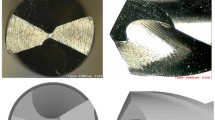Abstract
Drilled parts are prone to fatigue failure due to stress concentrating near the holes. As a result, the investigation of drilling-induced residual stresses can be of great importance. This study made an effort to present an analytical model to predict the distribution of residual stresses in drilling. The hole-making process was approximated by an orthogonal cutting model, with residual stresses being estimated using modified McDowell algorithm. The effects of drilling parameters, including cutting (feed and cutting speed), and drill bit (tool point and helix angles) parameters on surface residual stresses were investigated. Results revealed the formation of compressive residual stresses on hole surface in all conditions. The surface residual stresses decreased as the cutting speed and helix angle increased. However, an increase in feed and point angle caused residual stresses to rise. Nano-indentation method was used to validate the model. T test analysis demonstrated a good agreement between analytical and empirical results with an average difference of 23.1%. The only restriction was using the highest levels of cutting parameters due to ignoring white layer and phase change effects in the analytical model.
Similar content being viewed by others
References
Brinksmeier E, Cammett J, König W, Leskovar P, Peters J, Tönshoff H (1982) Residual stresses—measurement and causes in machining processes. CIRP Ann Manuf Technol 31(2):491–510
Macherauch E, Kloss K (1986) Proceedings of the International Conference on Residual Stresses. Garmisch-Partenkirchen, FRG:167–174
Lauro CH, Brandão LC, Ribeiro Filho SL, Valente RA, Davim JP (2015) Finite element method in machining processes: a review. In: Modern manufacturing engineering. Springer, pp 65–97
Su J-C, Young KA, Ma K, Srivatsa S, Morehouse JB, Liang SY (2013) Modeling of residual stresses in milling. Int J Adv Manuf Technol 65(5–8):717–733
Fergani O, Shao Y, Lazoglu I, Liang SY (2014) Temperature effects on grinding residual stress. Procedia CIRP 14:2–6
Fergani O, Lazoglu I, Mkaddem A, El Mansori M, Liang SY (2014) Analytical modeling of residual stress and the induced deflection of a milled thin plate. Int J Adv Manuf Technol 75(1–4):455–463
Agrawal S, Joshi SS (2013) Analytical modelling of residual stresses in orthogonal machining of AISI4340 steel. J Manuf Process 15(1):167–179
Huang K, Yang W, Chen Q (2015) Analytical model of stress field in workpiece machined surface layer in orthogonal cutting. Int J Mech Sci 103(1):127–140
Ulutan D, Alaca BE, Lazoglu I (2007) Analytical modelling of residual stresses in machining. J Mater Process Technol 183(1):77–87
Liang X, Liu Z, Wang B, Hou X (2018) Modeling of plastic deformation induced by thermo-mechanical stresses considering tool flank wear in high-speed machining Ti-6Al-4V. Int J Mech Sci 140(1):1–12
Tönshoff H, Spintig W, König W, Neises A (1994) Machining of holes developments in drilling technology. CIRP Ann Manuf Technol 43(2):551–561
Davim JP (2011) Machining of hard materials. Springer Science & Business Media
Zahavi E, Torbilo V, Press S (1996) Fatigue design: life expectancy of machine parts. CRC press, Florida
Strenkowski J, Hsieh C, Shih A (2004) An analytical finite element technique for predicting thrust force and torque in drilling. Int J Mach Tools Manuf 44(12–13):1413–1421
Ehmann K, Kapoor S, DeVor R, Lazoglu I (1997) Machining process modeling: a review. J Manuf Sci Eng 119(4B):655–663
Wu J, Di Han R (2009) A new approach to predicting the maximum temperature in dry drilling based on a finite element model. J Manuf Process 11(1):19–30
Lalwani D, Mehta N, Jain P (2009) Extension of Oxley’s predictive machining theory for Johnson and Cook flow stress model. J Mater Process Technol 209(12):5305–5312
Waldorf DJ, DeVor RE, Kapoor SG (1998) A slip-line field for ploughing during orthogonal cutting. J Manuf Sci Eng 120(4):693–699
Johnson KL, Johnson KL (1987) Contact mechanics. Cambridge university press
Fergani O, Jiang X, Shao Y, Welo T, Yang J, Liang S (2016) Prediction of residual stress regeneration in multi-pass milling. Int J Adv Manuf Technol 83(5–8):1153–1160
Huang K, Yang W (2016) Analytical modeling of residual stress formation in workpiece material due to cutting. Int J Mech Sci 114(1):21–34
Timoshenko S, Goodier J (1971) Theory of elasticity. McGraw-Hill, New York
Saif M, Hui C, Zehnder A (1993) Interface shear stresses induced by non-uniform heating of a film on a substrate. Thin Solid Films 224(2):159–167
Qi Z, Li B, Xiong L (2014) An improved algorithm for McDowell’s analytical model of residual stress. Front Mech Eng 9(2):150–155
McDowell D (1997) An approximate algorithm for elastic-plastic two-dimensional rolling/sliding contact. Wear 211(2):237–246
Khan A, Huang S (1995) Continuum theory of plasticity. Wiley, New York
McDowell D, Moyar G (1986) A more realistic model of nonlinear material response: application to elastic-plastic rolling contact. In: Second International Symposium on Contact Mechanics and Wear of Rail/Wheel Systems, July, 1986. pp 8–11
Jiang Y, Sehitoglu H (1994) An analytical approach to elastic-plastic stress analysis of rolling contact. J Tribol 116(3):577–587
Merwin J, Johnson K (1963) An analysis of plastic deformation in rolling contact. Proc Inst Mech Eng 177(1):676–690
DEFORM material library (2011) Scientific forming technologies corporation, Columbus, Ohio
Lee Y-H, Kwon D (2004) Estimation of biaxial surface stress by instrumented indentation with sharp indenters. Acta Mater 52(6):1555–1563
Balaji A, Sreeram G, Jawahir I, Lenz E (1999) The effects of cutting tool thermal conductivity on tool-chip contact length and cyclic chip formation in machining with grooved tools. CIRP Ann Manuf Technol 48(1):33–38
Agapiou J, Stephenson D (1994) Analytical and experimental studies of drill temperatures. J Eng Ind 116(1):54–60
Hassanpour H, Sadeghi MH, Rasti A, Shajari S (2016) Investigation of surface roughness, microhardness and white layer thickness in hard milling of AISI 4340 using minimum quantity lubrication. J Clean Prod 120(1):124–134
Author information
Authors and Affiliations
Corresponding author
Rights and permissions
About this article
Cite this article
Rasti, A., Sadeghi, M.H. & Farshi, S.S. An analytical study on residual stresses in drilling of hardened steel. Int J Adv Manuf Technol 99, 2389–2405 (2018). https://doi.org/10.1007/s00170-018-2587-4
Received:
Accepted:
Published:
Issue Date:
DOI: https://doi.org/10.1007/s00170-018-2587-4



